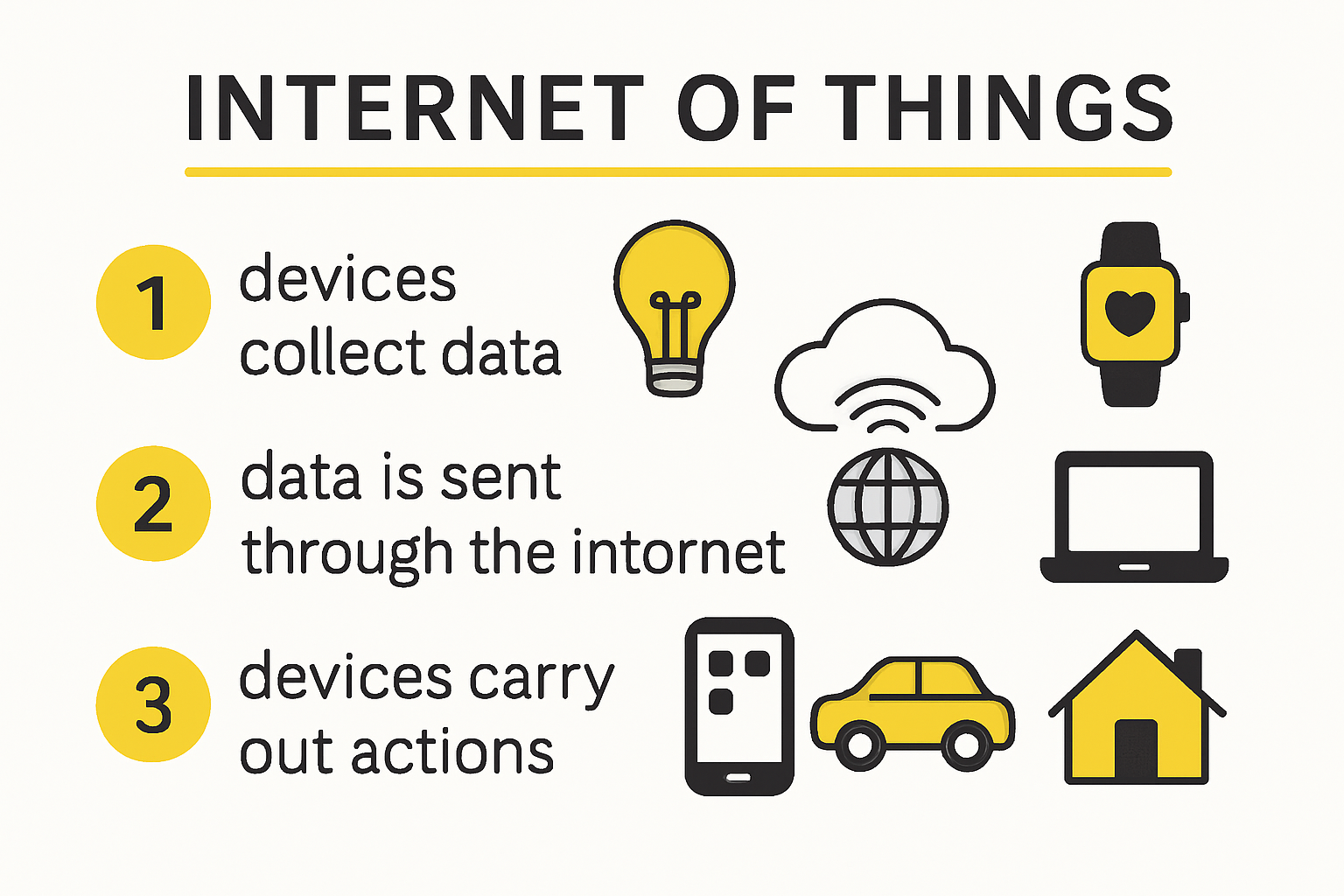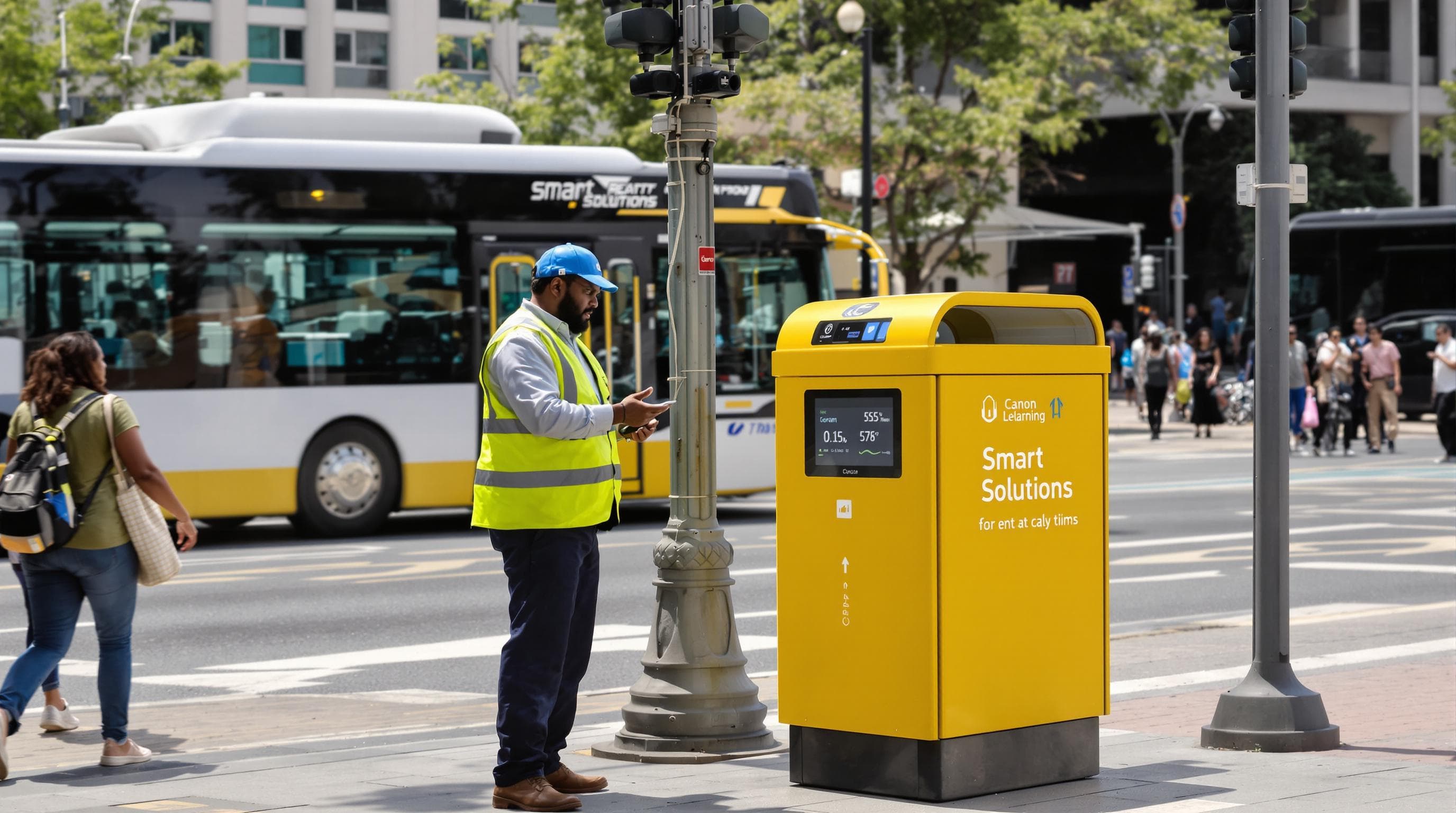
IoT is changing how we live and work every day. In just a year, experts expect homes to have an average of 18 connected devices, up from under 10 only a few years back. Most people think all this tech just means fancy gadgets and convenience. The real story is much bigger. These smart networks are quietly solving huge problems in South Africa, from slashing electricity costs to keeping patients healthy in rural towns.
Table of Contents
- Explaining What Is Iot And How It Works
- Real-Life Examples Of Iot In South Africa
- Benefits Of Iot For Homes, Health, And Business
- Future Trends Of Iot For All Lifestyles
Quick Summary
| Takeaway | Explanation |
|---|---|
| IoT is Transforming Industries | IoT devices are significantly improving efficiency in various sectors, including healthcare, manufacturing, and agriculture, by enabling real-time data collection and analysis. |
| Smart Home Benefits | IoT technologies in smart homes provide comprehensive monitoring and automation, enhancing personal efficiency and reducing energy costs by adapting to user preferences. |
| Healthcare Innovations | Connected medical devices facilitate continuous patient monitoring, leading to early intervention and reduced hospital readmission rates, especially in remote communities. |
| Environmental Impact | IoT applications in urban infrastructure, like smart waste management and air quality monitoring, are helping South Africa address environmental challenges and improve municipal operations. |
| Future of Personalized Ecosystems | By 2025, homes are expected to have an average of 18 connected devices, creating adaptive digital environments that enhance daily life through intuitive interactions. |
Explaining What Is IoT and How It Works
The Internet of Things (IoT) represents a revolutionary technological ecosystem where everyday devices communicate and interact seamlessly through internet connections. This transformative network goes far beyond traditional computing, connecting physical objects with digital intelligence in ways that were unimaginable just a decade ago.

The Core Mechanics of IoT Technology
At its fundamental level, IoT functions through a sophisticated network of interconnected devices equipped with sensors, software, and network connectivity. Gartner Research estimates that by 2025, over 75 billion devices worldwide will be IoT-enabled, creating an unprecedented web of smart communication.
These devices collect and exchange data through multiple communication protocols like WiFi, Bluetooth, cellular networks, and low-power wide-area networks (LPWAN). Each device acts as a data point, continuously gathering information about its environment, processing it locally or sending it to centralized cloud systems for advanced analysis.
Practical Applications Transforming Industries
IoT’s real power emerges in its practical applications across various sectors. In healthcare, IoT devices monitor patient vital signs remotely, enabling continuous health tracking. IEEE Technology reports that smart medical devices can reduce hospital readmission rates by up to 50% through proactive monitoring.
Industrial settings leverage IoT for predictive maintenance, where sensors on machinery detect potential failures before they occur. This approach minimizes downtime, reduces repair costs, and optimizes operational efficiency. Manufacturing, agriculture, transportation, and urban infrastructure are rapidly adopting IoT solutions to enhance performance and decision-making capabilities.
Understanding IoT’s Complex Ecosystem
The IoT ecosystem is not just about devices but about creating intelligent, responsive environments. Smart home systems exemplify this concept, where thermostats, security cameras, lighting, and appliances communicate and adapt based on user behavior and environmental conditions.
However, this interconnectedness also raises critical considerations around data privacy and cybersecurity. As devices become more integrated, protecting sensitive information and preventing unauthorized access becomes paramount. Manufacturers and developers must prioritize robust security protocols to maintain user trust and system integrity.
By 2025, IoT will be less of a technological novelty and more of an essential infrastructure driving innovation across global systems. Its ability to transform raw data into actionable insights makes it a cornerstone of the emerging digital transformation landscape, promising smarter, more efficient, and more responsive technological experiences.
Real-Life Examples of IoT in South Africa

South Africa stands at the forefront of innovative IoT implementations, transforming critical sectors through intelligent technological solutions that address unique local challenges and drive sustainable development.
Urban Infrastructure and Environmental Monitoring
In Johannesburg, urban planners are revolutionizing waste management through cutting-edge IoT technologies. Researchers from the University of Witwatersrand have designed a sophisticated smart waste management system integrating sensor networks that provide real-time tracking of waste collection routes, bin fill levels, and optimal disposal strategies. This IoT-driven approach significantly reduces operational costs and improves municipal efficiency.
Air quality monitoring represents another critical application of IoT in South African cities. The innovative Ai_r project deploys networked sensors across urban centers like Soweto and Braamfontein, enabling continuous environmental monitoring. These IoT devices collect granular data on pollutant levels, helping city officials and health professionals make informed decisions about urban environmental interventions.
Industrial Safety and Resource Management
The mining sector, a cornerstone of South Africa’s economy, has embraced IoT technologies to enhance worker safety and operational efficiency. The Council for Scientific and Industrial Research (CSIR) has developed advanced underground monitoring systems that utilize sensor networks to detect potential geological hazards in coal mines. These IoT solutions provide early warnings about structural instabilities, significantly reducing workplace accidents and protecting human lives.
Precision agriculture represents another domain where IoT is making substantial impacts. Farmers are now implementing smart irrigation systems that use soil moisture sensors, weather tracking devices, and satellite imaging to optimize water usage. These technologies enable farmers to make data-driven decisions, conserve resources, and improve crop yields in challenging agricultural environments.
Healthcare and Community Wellness
In response to healthcare accessibility challenges, South African innovators are deploying IoT solutions to extend medical services into remote communities. Wearable health monitoring devices connected to centralized health platforms allow continuous patient tracking, enabling early intervention and reducing the burden on traditional healthcare infrastructures.
Remote clinics can now receive real-time patient data, track medication adherence, and provide personalized health recommendations. This approach is particularly transformative in rural areas where medical resources are limited and transportation challenges can impede consistent healthcare delivery.
These real-world implementations demonstrate that IoT is not merely a technological trend in South Africa but a practical tool for solving complex societal challenges. By integrating intelligent sensor networks, data analytics, and connectivity, the country is creating scalable solutions that address infrastructure, environmental, industrial, and healthcare needs with remarkable innovation and efficiency.
To highlight the diverse impact of IoT across sectors in South Africa, here’s a summary table of key implementations and their benefits:
| Sector | Example Application | Main Benefit |
|---|---|---|
| Urban Infrastructure | Smart waste management and air quality sensors | Reduced costs, better municipal efficiency |
| Industrial (Mining) | Underground hazard monitoring with sensors | Improved worker safety, accident reduction |
| Agriculture | Smart irrigation, soil moisture/weather sensors | Better resource use, higher crop yields |
| Healthcare | Wearable health devices, remote patient tracking | Better access, early intervention, fewer readmissions |
Benefits of IoT for Homes, Health, and Business
IoT technologies are rapidly transforming how we interact with our environments, offering unprecedented advantages across personal, professional, and healthcare domains. These intelligent systems create seamless, adaptive experiences that enhance efficiency, safety, and quality of life.
Smart Home Innovations and Personal Efficiency
Research from the National Center for Biotechnology Information reveals that smart home technologies provide comprehensive monitoring capabilities that extend far beyond simple convenience. IoT-enabled home systems can track physical activities, monitor sleep patterns, and create personalized living environments that respond dynamically to individual needs.
Home automation now allows residents to control lighting, temperature, security, and appliances through integrated networks. These systems learn user preferences over time, automatically adjusting settings to optimize energy consumption, reduce utility costs, and create more comfortable living spaces. For instance, smart thermostats can predict occupancy patterns and adjust temperatures accordingly, potentially reducing energy expenses by up to 25%.
Healthcare Transformation through Connected Technologies
The National Institute of Standards and Technology highlights IoT’s revolutionary potential in healthcare delivery. Connected medical devices enable continuous patient monitoring, allowing individuals to receive professional healthcare support while remaining in the comfort of their homes.
Wearable health devices now provide real-time tracking of vital signs, medication adherence, and chronic condition management. These technologies empower patients with immediate health insights while simultaneously giving healthcare providers comprehensive data for more personalized treatment strategies. Remote monitoring reduces hospital readmission rates and enables early intervention for potential health complications.
Business Efficiency and Operational Intelligence
For businesses, IoT represents a paradigm shift in operational management. Interconnected sensor networks provide granular insights into workflow processes, equipment performance, and resource allocation. Companies can implement predictive maintenance strategies, identifying potential machinery failures before they occur and minimizing costly downtime.
A systematic review in the Journal of Medical Internet Research emphasizes the importance of user-centric design in IoT solutions. This principle extends beyond healthcare into business contexts, where adaptive technologies can create more responsive and intelligent work environments.
Manufacturing, logistics, and service industries benefit from IoT through enhanced inventory tracking, supply chain optimization, and real-time performance analytics. These technologies enable businesses to make data-driven decisions, reduce operational costs, and create more agile, competitive organizational structures.
The convergence of IoT across homes, health, and business sectors represents more than a technological trend. It signifies a fundamental reimagining of how we interact with our surroundings, transforming passive environments into intelligent, responsive ecosystems that anticipate and fulfill human needs with remarkable precision and efficiency.
Below is a table summarising the main benefits and examples of IoT across homes, healthcare, and business:
| Domain | Main Benefits | Examples of IoT Application |
|---|---|---|
| Home | Energy saving, convenience, personalisation | Smart thermostats, automated lighting, security |
| Healthcare | Early intervention, continuous monitoring, comfort | Wearable health monitors, remote tracking |
| Business | Operational efficiency, lower downtime, better insights | Predictive maintenance, supply chain optimisation |
Future Trends of IoT for All Lifestyles
The Internet of Things (IoT) is rapidly evolving beyond current technological boundaries, promising transformative experiences across personal, professional, and societal domains. As we approach 2025, IoT is set to redefine how we interact with technology, creating more intelligent, responsive, and interconnected environments.
Personalized Digital Ecosystems
Verizon’s 2024 Consumer Connections Report reveals a fascinating trend of increasing digital connectivity. By 2025, households are expected to own an average of 18 connected devices, creating intricate personal technology ecosystems that adapt and respond to individual lifestyles.
These personalized digital environments will seamlessly integrate across multiple platforms, enabling more intuitive and context-aware interactions. Smart devices will not just respond to commands but anticipate user needs, learning from behavioral patterns and creating more efficient, customized experiences. Parents, for instance, can leverage technologies like smart watches to enhance child safety and independence, demonstrating IoT’s potential to address specific lifestyle requirements.
Industrial and Urban Transformation
IoT Engineering Insights highlight the critical role of IoT in reshaping industrial landscapes. Manufacturers and urban planners are developing advanced systems that integrate artificial intelligence, edge computing, and comprehensive sensor networks to create more responsive and efficient environments.
Smart cities will emerge as prime examples of IoT’s transformative potential. Urban infrastructure will become increasingly intelligent, with systems that dynamically manage traffic flow, optimize energy consumption, and enhance public safety. IoT-enabled technologies will support sustainable urban development, reducing environmental impact while improving citizens’ quality of life through data-driven decision-making.
Connectivity and Security Innovations
Smart City Technology Trends indicate a significant focus on advanced connectivity technologies like 5G-Advanced and edge computing. These innovations will enable faster, more reliable communication between devices, supporting more complex and responsive IoT ecosystems.
Cybersecurity will become paramount as IoT systems become more integrated into critical infrastructure. Emerging technologies will prioritize robust security protocols, implementing advanced encryption, AI-driven threat detection, and decentralized security models to protect sensitive data and maintain user trust.
The future of IoT extends far beyond technological advancement. It represents a fundamental reimagining of human-technology interaction, where digital systems become seamlessly integrated into our daily lives. By creating more intelligent, responsive, and personalized experiences, IoT will continue to break down barriers between physical and digital worlds, offering unprecedented levels of convenience, efficiency, and connectivity across all lifestyle domains.
Frequently Asked Questions
What is the Internet of Things (IoT)?
The Internet of Things (IoT) refers to a network of interconnected devices that communicate and exchange data over the internet, enabling them to work together intelligently and efficiently.
How does IoT technology work?
IoT technology works through a combination of sensors, software, and network connectivity that allows devices to collect, send, and receive data, facilitating real-time monitoring and automation across various sectors.
What are some practical applications of IoT in South Africa?
IoT is applied in South Africa in various ways, including smart waste management systems, underground hazard monitoring in mining, and remote patient monitoring in healthcare, showcasing its impact on urban infrastructure, industrial safety, and community wellness.
What benefits do IoT technologies offer for homes and businesses?
IoT technologies enhance personal efficiency in smart homes by providing automation and energy savings, while for businesses, they improve operational efficiency, reduce downtime, and support data-driven decision-making.
Bring Smart Technology Home: Discover Real IoT Solutions for South Africans
Are you ready to move beyond the promise of IoT and start experiencing the benefits in your own life? The article shows how connected devices solve real problems from high energy bills and limited healthcare access to creating safer, more efficient homes. South Africans need practical technology that delivers reliability and peace of mind at a price that fits the local economy. Whether you want to automate your home, stay on top of your health, or simply enjoy the convenience of modern gadgets, we understand your journey toward a smarter lifestyle.
Explore the latest in smart wearables, health devices, and home automation on our Best-Selling Technology Collection. Thousands of South Africans already trust us for quality, compatibility, and fast local delivery. Now is the ideal time to turn knowledge into action. Visit PMC Jewellery’s smart technology marketplace and find solutions designed for everyday challenges. Make your 2025 smarter, more efficient, and future-ready—see our top picks and join the connected generation today.
Recommended
- Butterfly Buckle Dual-tone Liquid Silicone Watch Band For Apple Watch – PMC Jewellery
- 20mm Top Layer Cowhide Sewing Watch Band For Apple Watch Series 9&8&7 – PMC Jewellery
- HZQW-101 Silent Alarm Shock Smart Wireless Watch Bed Rest Corrector(Bl – PMC Jewellery
- Metal Earrings Simple Geometric Embossed Floral Earrings Retro Fashion – PMC Jewellery
